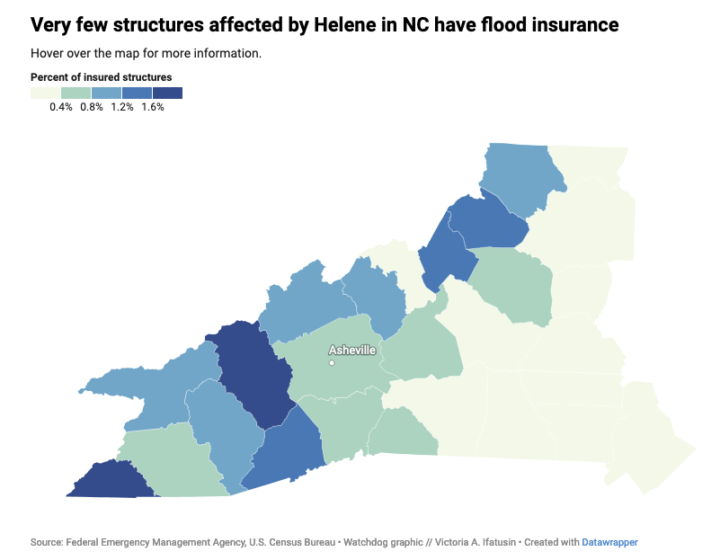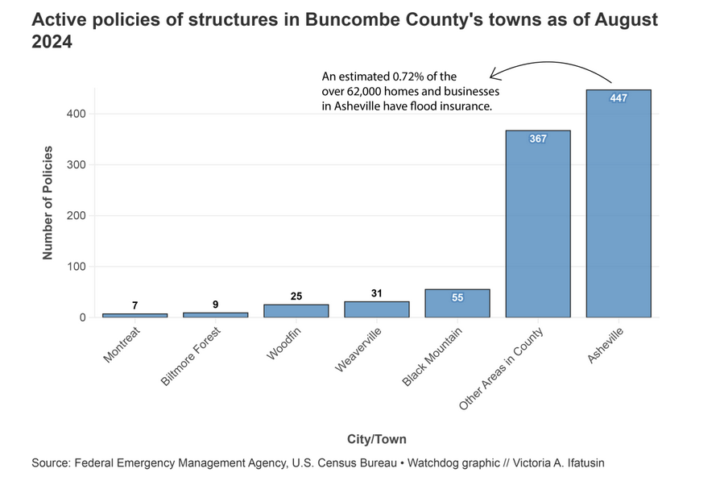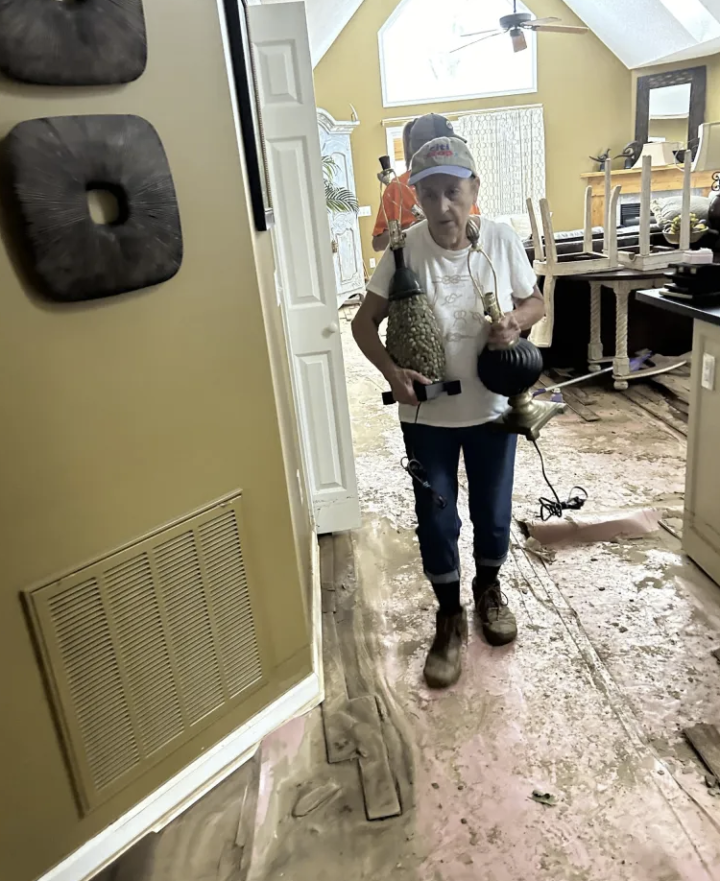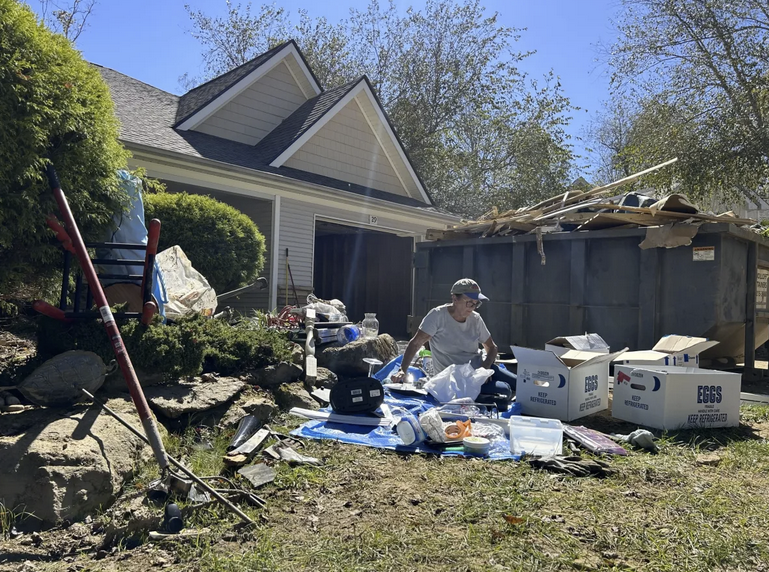Buncombe homeowners hit hardest by flood damage from Hurricane Helene will likely face enormous costs to rebuild with limited options to pay for it.
Fewer than one percent of Buncombe structures, including homes and businesses, are covered by flood insurance, according to an Asheville Watchdog analysis of data from the National Flood Insurance Program (NFIP) and U.S. Census Bureau.
Flood damage typically is not covered by homeowners’ insurance policies. The Federal Emergency Management Agency (FEMA) provides assistance for uninsured losses up to a maximum of $45,000.
With entire neighborhoods washed away by the unprecedented flooding from Helene, the cost of rebuilding a home or business and replacing the contents could far exceed that assistance.
 “People thought it wouldn’t happen to them,” Donald T. Hornstein, a professor of law and director of the law school’s Center for Climate, Energy, Environment and Economics at the University of North Carolina, told The Watchdog.
“People thought it wouldn’t happen to them,” Donald T. Hornstein, a professor of law and director of the law school’s Center for Climate, Energy, Environment and Economics at the University of North Carolina, told The Watchdog.
“It’s a problem [with] the disaster that has unfolded in Western North Carolina, which includes a huge amount of flood losses, which will be excluded from regular homeowners policies.”
Hornstein said a typical homeowner’s insurance policy covers losses from situations like a tree falling on the house. But water coming into the house from the ground up, mud flows coming down, or the house collapsing from flood waters, would not be covered.
“That exclusion has been [standard] in homeowners’ policies for, like, half a century,” Hornstein said.
And for business owners, Hornstein said that business interruption insurance might kick in and help.
Asheville Watchdog analyzed active insurance policies of structures as of August 2024 for all North Carolina counties that FEMA listed as eligible for Individual Disaster Assistance, a program that provides financing to residents in declared-disaster areas.
The entire western part of North Carolina, 28 counties in all including the Eastern Band of Cherokee Indians of North Carolina, was declared a federal disaster area as of Oct. 5.
On average, policyholders in Buncombe County pay nearly $2,000 a year for flood insurance, the data show.
Asheville follows Buncombe County’s trend, as the structures with flood insurance account for an estimated 0.72 of homes and businesses. Owners in Asheville pay an average of more than $2,300 for flood insurance, according to the data.
 The federal government requires flood insurance for homeowners who have a government-backed mortgage in FEMA’s high-risk flood zone areas, based on FEMA maps. In North Carolina, about 40 percent of the homes with flood insurance are in the coastal eastern part of the state, according to the National Flood Insurance Program data.
The federal government requires flood insurance for homeowners who have a government-backed mortgage in FEMA’s high-risk flood zone areas, based on FEMA maps. In North Carolina, about 40 percent of the homes with flood insurance are in the coastal eastern part of the state, according to the National Flood Insurance Program data.
But FEMA’s flood zone maps are “notoriously understated” and “the flood risk is worse” than the maps currently show, Hornstein said. Data from FEMA show there are 1,032 structures in Asheville that are in a flood zone, and only 43 percent of those structures have flood insurance. Many people impacted by hurricane flooding were outside FEMA’s declared high-risk flood zones.
“So they wouldn’t have a clue when they got their homes that they needed [flood insurance], because they weren’t in a flood zone,” Hornstein said. “More attention has to be paid to places far away from the coast that increasingly are subject to these deluges and flood risks.”
‘If you don’t live in a floodplain, why have it?’
Connie Sandford is one of the people whose homes were damaged by the flood, but didn’t have flood insurance.

The 78-year-old woke in the middle of the night to help two of her neighbors as they tried to clear the storm drains in front of her Swannanoa house as tropical storm Helene approached. But the drain couldn’t handle the amount of water from the rain along with the debris that clogged it. The water rose and flowed into her home.
“I just got a push broom and opened the back door and kept pushing water out,” she said. “And then, I just didn’t have any strength left — I just laid down on the sofa and cried and stayed there for the night.”
Sandford said she has lived in her home in the Bee Tree community for more than 23 years. Within a night, nearly all of it was gone.
“It’s like you’re in shock. You’ve lost everything — your home, appliance, furniture, everything,” she said. And she had no flood insurance.
Sandford said she had researched North Carolina cities listed as being at risk of flooding and didn’t see any cities mentioned in the mountainous western part of the state.
“If you don’t think you need flood insurance, you don’t live in a high flood plain, why would you have it?” she asked. “It’s very expensive.”
She said she pays more than $1,000 a year for homeowner’s insurance, but flooding — and mold from the flood damage — will not be covered.
National problem
Darrell Habisch, a spokesman for FEMA, said that the lack of flood insurance in homes is a national problem because it’s optional for people living outside of the flood zones.
“We wish everyone would participate in [the National Flood Insurance Program]” Habisch said. “We recommend that everybody take the necessary steps to protect themselves from these types of unexpected disasters and situations.”
For the tiny portion of homeowners who carry NFIP insurance in Buncombe County and Western North Carolina, damages up to $250,000 for structures and $100,000 for belongings are covered.
For people who lost their homes and don’t have insurance, both Hornstein and Habisch said that not all hope is lost.
Uninsured homeowners can apply for FEMA’s Individual Disaster Assistance. Habisch said it can provide a maximum of $45,000 per individual, homeowner and renter for immediate needs like replacement furniture, kitchen appliances, assisted living accommodations, sanitary products, gas, lack of utilities, and more.
But FEMA disaster assistance is a fallback and “is not designed to be the equivalent of a replacement for flood insurance,” Hornstein said.
“You can get thousands of dollars from that, but that’s not going to cover, nor is it designed to cover, the full losses that people face, especially from flooding events,” Hornstein said.
After everything, questions swarm Sandford’s mind.
“I’m just thinking, What am I going to do with this property? It’s going to cost me a lot of money,” she said. “Do I want to take on a huge debt? My home was paid for. Do I want to live there again? Do I want to go into debt to rebuild that again?”
“There’s just so many questions, so many things to consider,” she said.
Residents impacted by the storm and flood from Hurricane Helene can apply for disaster relief aid by going online to https://www.disasterassistance.gov/ or by calling (800) 621-3362.
Asheville Watchdog is a nonprofit news team producing stories that matter to Asheville and Buncombe County. Investigative reporter Victoria A. Ifatusin joined us through a 12-month fellowship as part of the Scripps Howard Fund’s Roy W. Howard Fellowship program. You can reach her via email at vifatusin@avlwatchdog.org. The Watchdog’s reporting is made possible by donations from the community. To show your support for this vital public service please visit avlwatchdog.org/support-our-publication/.




Before you comment
The comments section is here to provide a platform for civil dialogue on the issues we face together as a local community. Xpress is committed to offering this platform for all voices, but when the tone of the discussion gets nasty or strays off topic, we believe many people choose not to participate. Xpress editors are determined to moderate comments to ensure a constructive interchange is maintained. All comments judged not to be in keeping with the spirit of civil discourse will be removed and repeat violators will be banned. See here for our terms of service. Thank you for being part of this effort to promote respectful discussion.